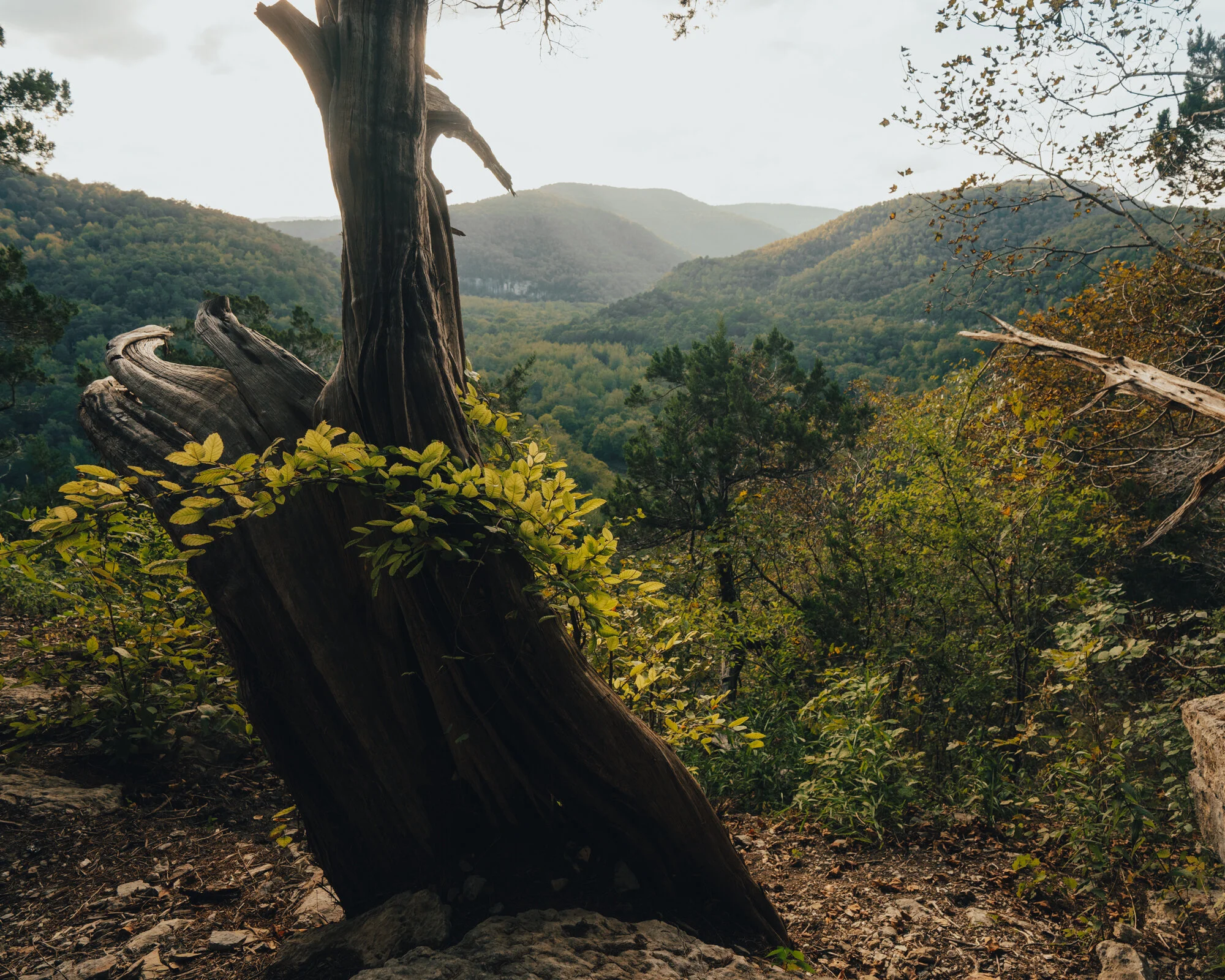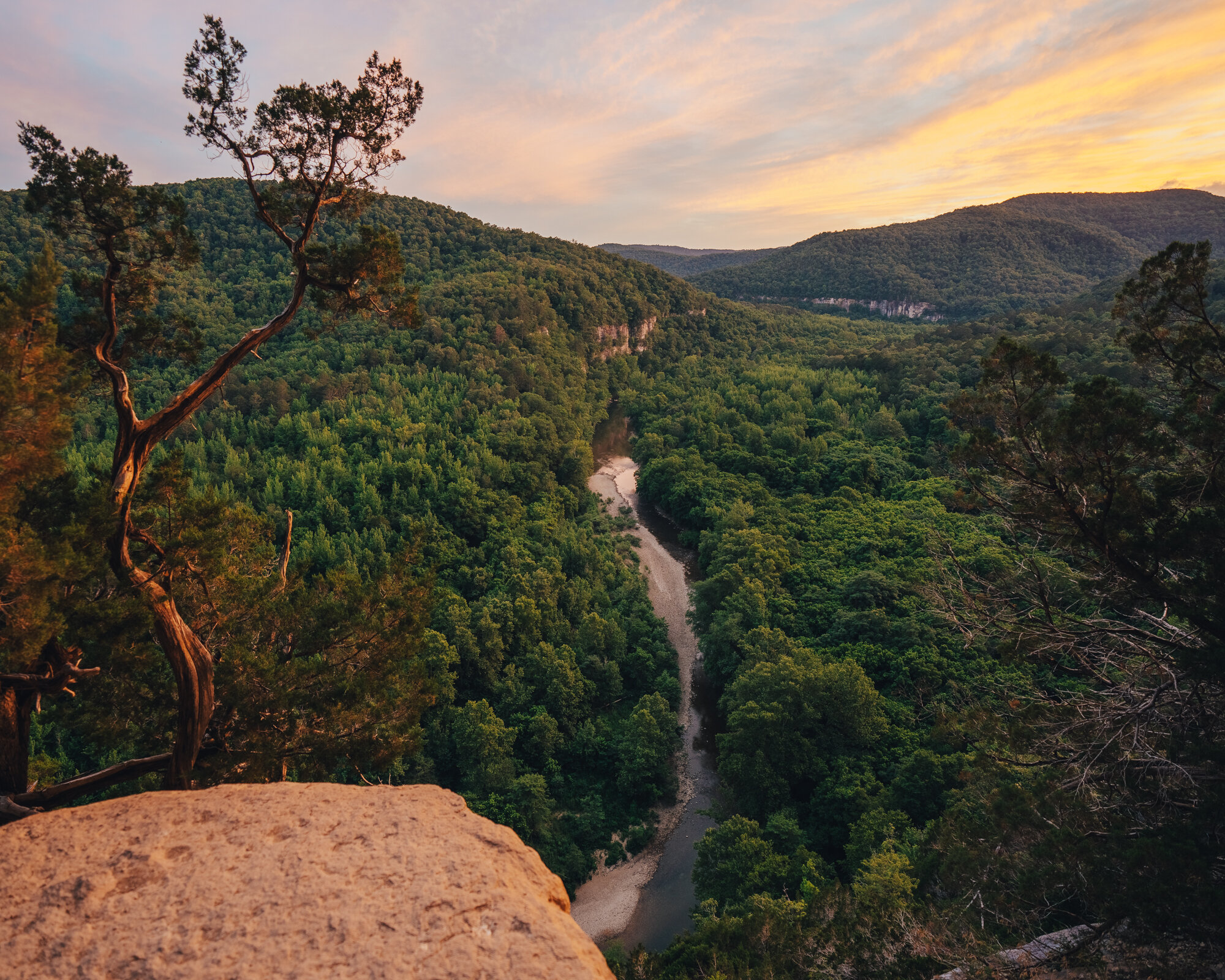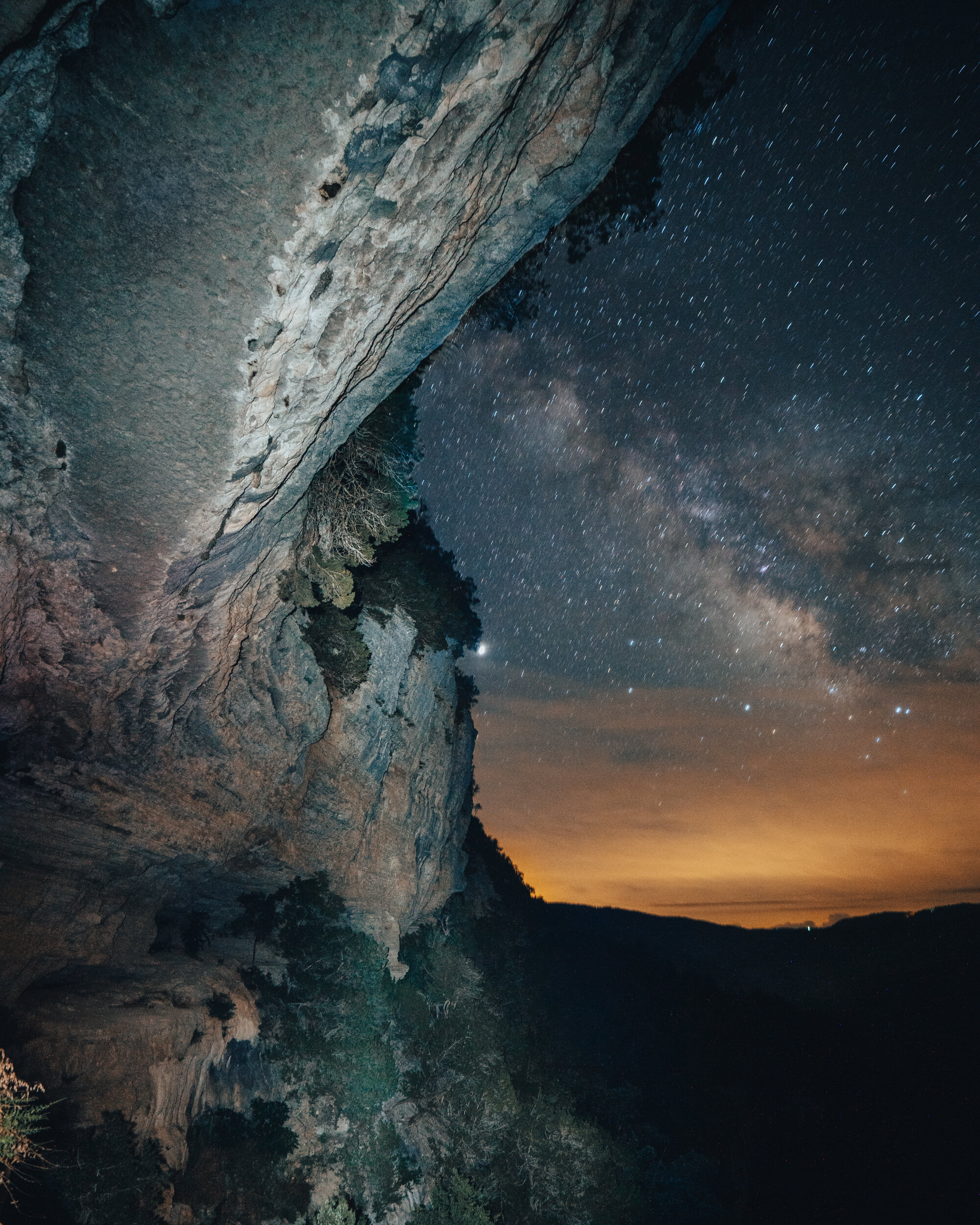The Goat Trail along Big Bluff
Buffalo National River
Basking in evenings glow-the Buffalo River flows below the Goat Trail on Big Bluff.
If I had to choose the most scenic viewpoint in Arkansas, then the view from the Goat Trail on Big Bluff over the Buffalo National River would have to be my pick. The vast panoramic views of the Buffalo winding through the mountains and bluffs of the Ponca Wilderness are unique and unparalleled. The bluff itself is "said to be" the tallest sheer vertical cliff face found between the Appalachians and the Rockies, with an estimated height of 560 feet! However, the Goat Trail runs along this cliff face at around 340 feet above the river.
On Tuesday, I decided to make my second hike out to the "big" bluff (this week). Because it's Milky Way season and Sunday nights attempt to catch the galactic center from the Goat Trail was foiled by dense fog socking me in (However, it did provide some beautiful foggy Monday morning views over the river). This particular evening seemed to have favorable conditions, so with my fingers crossed, MC and I headed over to the Centerpoint Trailhead to make our way down!
Whiteout conditions along the Goat Trail, a hiker illuminates a narrow bend from an alcove in Big Bluff, trying to see through the thick fog that has rolled in with the cooler evening temps. Shot during my first milky way attempt of the week.
Winding through the fog, the Buffalo River finally begins to emerge from the white veil of haze. Shot the morning after getting socked in by fog on the Goat Trail.
The three-mile hike down the Centerpoint trail went by pretty quickly. I left my camera in my pack and just went full steam down the old road. The descent down to the Goat Trail would be a pleasant stroll if it weren’t for the fact the road has been rutted out so severely by rain erosion and the hooves of horses. I often think about how great it would be if the county could still maintain this road and people could drive down it to get to the Goat Trail. I usually tell people thinking about hiking the trail that it feels like two miles down and six back out thanks to the one thousand plus feet of elevation change from start to finish. Still, the trail is popular enough as it is, and the big hike back out is one of the only things that seem to control those numbers these days slightly.
We arrived well before sunset at the fork of the Centerpoint Trail and the Goat trail - found on a large saddle in the mountain with open woods that are perfect for hammocks and an existing fire ring. This large saddle is where I usually try to camp, but several occupants were already there, so we used our extra time to scout out another option for camp. If you take the little well-worn spur trail to the right of the fire pit, it will lead you to Big Bluff, and if you stay straight on the main path, it eventually takes you all the way down to the river.
My usual campsite at the fork of the Centerpoint Trail and the Goat Trail on a large saddle in the mountain with open woods that are perfect for hammocks and an existing fire ring.
We decided to go to the far end of the Goat Trail and follow the path which leads down to the river to look for campsites off of the bluff (Camping on Big Bluff is prohibited by the National Park Service). We also took a side hike to bushwhack up to the top of Big Bluff and found a few impressive views, but the woods and underbrush were so thick that we decided to make our way back down before making it to the highest point.
During our excursion, we found a nice campsite away from the bluff, down on a flat open expanse on the mountain's ridge, with some decent trees for hammocks and an existing fire ring. We decided to call this home for the evening and set up our hammocks since it would be well after dark before we made it back.
Making camp on a flat open expanse of forest along the ridge of the mountain past the Goat Trail.
We made our way back toward the overlooks along the goat trail and through one of my favorite areas along the path, which wanders through a thicket of ancient junipers. Some of these trees have been dated back to over 800 years old by the National Park Service! After some time spent with these twisted and weathered beauties, we found our front row seats for sunset on the narrow sandstone ledges of the Goat Trail.
Sunset was more impressive than I had expected it would be - based on the time that the radar showed the clouds were going to move out. We ended up getting to witness a very vibrant and impressive sunset with a 180-degree view of the Buffalo River meandering through the Ozarks.
Ancient Juniper overlooking the Ponca Wilderness from the edge of Big Bluff.
Front-row seat for a sunset on the narrow sandstone ledges of the Goat Trail.
The Buffalo meandering through the Ozarks viewed from the Goat Trail at sunset.
Toward the end of sunset, we witnessed an incredible show as the moon set along with it. At the same time, lightning bugs began to dart all around the edge of the bluff. We enjoyed the show and ate some snacks we had brought to the bluff side. After the moon set, we still had a little time before the clouds would move completely out and the milky way would be fully visible. Thankfully there didn’t seem to be much moisture in the air, and no fog had begun to form, so it looked like tonight was the night for clear viewing of the milky way from the Goat Trail!
Around midnight, the milky way was in the proper position, and clouds had moved out enough for a great view of the galactic center! It was a beautiful sight, and I spent several hours snapping photos before calling it a night.
Moonset and fireflies viewed from the Goat Trail.
Self Portrait below the Milky Way
The Milky Way viewed from the Goat Trail on Big Bluff.
The Basics
Centerpoint Trail to the Goat Trail
Difficulty: Strenuous Length: 6 Miles Roundtrip Elevation: 1076 ft





































